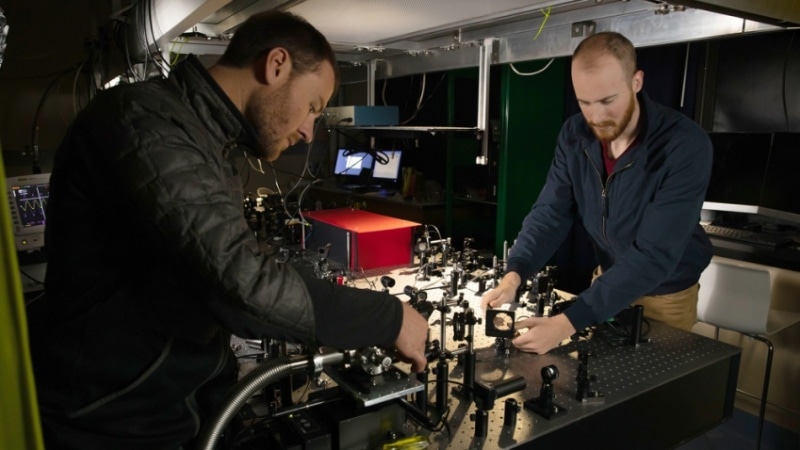Oct 18 2019
Physicists at the University of Oregon have formulated a new method of measuring light—with the help of microscopic drums to hear light.
 (Image credit: University of Oregon)
(Image credit: University of Oregon)
The technology from the Alemán Lab, known as a “graphene nanomechanical bolometer,” exploits a prospective new method and material to detect almost every color of light at high temperatures and high speeds.
“This tool is the fastest and most sensitive in its class,” said Benjamín Alemán, a professor of physics and a member of the University of Oregon’s Center for Optical, Molecular, and Quantum Science and an associate of the Phil and Penny Knight Campus for Accelerating Scientific Impact.
The device provides a substitute for the traditional way of using electricity to measure light, as seen in devices such as a smartphone’s camera. Rather, this mechanical technique captures the vibrations of infinitesimally thin drums which are triggered by light. The physicists acquire the measurements by paying attention to the sound of the light absorbed by the drumhead.
The way the technology operates is akin to the effect of beating a drum on a hot day. When the sun heats the instrument, the drumhead membrane will expand causing its pitch to vary, releasing a tone different from what it would at cooler temperatures.
The light waves do the same thing to the mechanical bolometers. As light touches the device’s drumhead, the membrane heats up, expands, and the vibrational pitch alters. The team could monitor these pitch variations to measure how much light reaches the device.
“This is a very new way of detecting light,” said David Miller, a doctoral student in the Alemán Lab. “We’re using a purely mechanical method to turn light into sound. This has the advantage of being able to see a much broader range of light.”
He adds that traditional detectors are very dependable at reading high-energy light, like X-rays or visible light, but less capable at measuring the lengthier wavelengths on the electromagnetic spectrum, including radio waves and infrared. The mechanical device fills that void and enables the physicists to detect light of almost any wavelength, which could be particularly beneficial in astronomical observations, thermal and medical body imaging and observing deep into the infrared.
The team built the device by first broadening a thin sheet of atoms over a hole etched into a piece of silicon. Then, using a method formulated beforehand in the lab, they cut the sheet to look like an extremely small trampoline.
The device measures one-tenth the width of a human hair, while the material used for the trampoline is even smaller—a single atom thick, about a million times thinner than that same strand of hair.
This system uses graphene, which is just a single layer of atoms. It’s as small as it can be.
Andrew Blaikie, Study Lead Author and Doctoral Student, Alemán Lab
The paper was recently published in Nature Communications.
Discovered in 2004, graphene is the core ingredient for the technology’s success. It is a small, but robust material. Despite being the thinnest possible material, graphene is 200 times stronger than steel and extremely flexible. The discoverer of this material even won the 2010 Nobel Prize in physics for its potential to transform physics and engineering.
The mechanical properties of graphene allow the material to react to temperature variations extremely fast, which allows it to measure light at correspondingly speedy rates.
Graphene offered a tantalizing prospect for ultrasensitive and ultrafast light detection. It also possesses an unmatched ability to measure nearly any wavelength of light and can withstand much higher temperatures than conventional detectors.
Andrew Blaikie, Study Lead Author and Doctoral Student, Alemán Lab
The physicists were able to exploit the powers of graphene through its mechanical method to measuring light. While full of potential for light detection, the material has not performed well through the traditional approaches of using electrical resistance to measure light, largely because of its need to be chilled to ultra-low temperatures to be beneficial in traditional detectors.
When they understood they could convert light into sound through their mechanical technique, they were able to expose the prospects of graphene and develop the ultrafast, ultrasensitive device that shines at, and far beyond, room temperature.
Its ability to work at such a broad range of temperatures is one of the device’s most beneficial qualities with regards to measuring light, Blaikie explained. It can work at room temperature, which facilitates critical portability, and it can work under high heat, which is an advantage that conventional light detectors do not offer, as many of them will fail what is known as the “sunburn effect,” when they start to break down as temperatures increase.
Graphene is a thermally stable material that can withstand temperatures over 2,000 degrees Celsius.
Andrew Blaikie, Study Lead Author and Doctoral Student, Alemán Lab
With its flexibility and ultrasensitive nature position, the nanomechanical bolometer is likely to become a suitable tool in several domains across medicine, industrial manufacturing, science, and astronomy. The Alemán Lab is awaiting a patent for the technology.
“We hope this device will help scientists crack the mysteries of our sun and other stars, improve medical diagnostics through safer thermal X-ray imaging, and help firefighters see better in fires to save more lives,” Alemán said.